The Uplifting Loopy Quarterloop Uplift Mast Arms
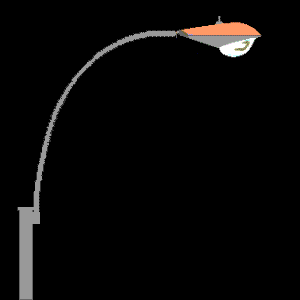 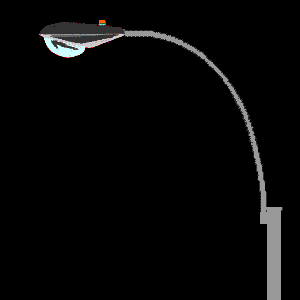 The uplifting tale of the soaring, quarter rounded uplift street lighting mast arms that swooped in on New York City like a flock of steel tubed locusts from the early 1960s through well into the 1980s, coupled with the mass invasion of mercury vapor cobra head street lighting. The uplifting tale of the soaring, quarter rounded uplift street lighting mast arms that swooped in on New York City like a flock of steel tubed locusts from the early 1960s through well into the 1980s, coupled with the mass invasion of mercury vapor cobra head street lighting.
|
| The world was a fairly predictable place prior to
my 6th year. Every day I went to school and every day I returned
home to Booth Street in Rego Park, Queens, New York City. My block on Booth Street never changed. Then one day I returned home from kindergarten, and there they were...where only that morning, as I left for school, my old familiar tapered elliptical "crook arm" masted incandescent Westinghouse "cuplight" street lights still held sway... The infamous Quarter Loops streetlight arms and their evil partners in crime, the "Disgusted" (GE M400) mercury vapor fluorescent fixtures. |
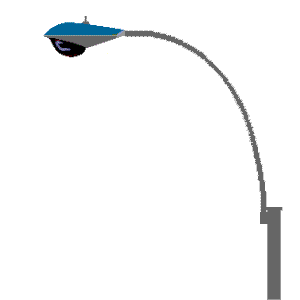 Ironically I don't believe I missed the cuplights as much
as the crookarms. I was aware that other streets had mercuries
and since kids usually want the latest new toy, I wanted my street
to have the latest new light. I'd cry over the demise of the
cups in later years. What I never took well to was the quarter
loop arms. Why the city saw any need for them, I have no idea.
Like their stainless aluminum standard contemporaries, the Donald Deskey designed "Bigloops",
the quarterloops sprouted in the 1960's, like some luminous fungus.
Why did I take such a dislike to the Q-loops? They probably suffered
guilt by association to the Disgusteds. It didn't help them that I was also very attached to the
familiar crookarms.
Ironically I don't believe I missed the cuplights as much
as the crookarms. I was aware that other streets had mercuries
and since kids usually want the latest new toy, I wanted my street
to have the latest new light. I'd cry over the demise of the
cups in later years. What I never took well to was the quarter
loop arms. Why the city saw any need for them, I have no idea.
Like their stainless aluminum standard contemporaries, the Donald Deskey designed "Bigloops",
the quarterloops sprouted in the 1960's, like some luminous fungus.
Why did I take such a dislike to the Q-loops? They probably suffered
guilt by association to the Disgusteds. It didn't help them that I was also very attached to the
familiar crookarms.
|
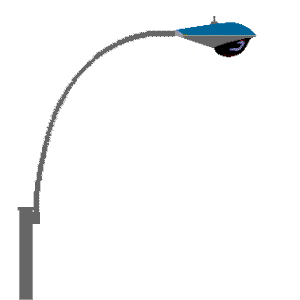 I loved the crookarms the best over all other poles. I drew them
all the time. Maybe at six, I couldn't draw curved lines good,
rendering me unable to master the drawing of the new loopy arms.
That would've been a good reason to hate them. I think I just
didn't like them, because. At six, you don't need much more of
a reason to dislike something. I loved the crookarms the best over all other poles. I drew them
all the time. Maybe at six, I couldn't draw curved lines good,
rendering me unable to master the drawing of the new loopy arms.
That would've been a good reason to hate them. I think I just
didn't like them, because. At six, you don't need much more of
a reason to dislike something.The irony is that I was not usually averse to new things, but I was hostile to unusual things and asymetrical things. The crookarms were usual. They were everywhere when I was little. A new, shiny crookarm pole would be a welcome new thing. The still uncommon loop was unwelcome. It made my block wierd, in a crookarm world. I might face discrimination someday, for being a Loopian. |
|
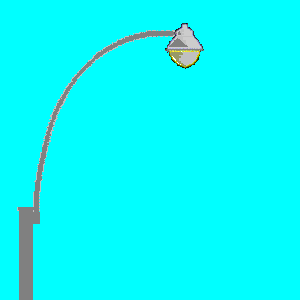 Almost never had incandescents,
I should say. There was one single solitary q-loop that I know
of, that had a cuplight. As usual, it was the Belt Parkway that
provided the stage. The Belt itself had no q-loops, but its erstwhile
service road in Queens; Conduit Boulevard did. Near Aqueduct Racetrack,
just before Conduit swings away from the Belt, I spied one Q-loop
with a cuplight back in the early 1980's. That stretch of Conduit
was late ditching the incandescents, as was the Belt Parkway that it served as a service road, but that
cuplight was just one of a scattered few still left in the 1980's.
Why each of those lights were missed in the sweeping vaporization
of those roads, I'll never know. It's possible that some DOT
workers, who think like me, strove to save a few for sentimental
reasons. Almost never had incandescents,
I should say. There was one single solitary q-loop that I know
of, that had a cuplight. As usual, it was the Belt Parkway that
provided the stage. The Belt itself had no q-loops, but its erstwhile
service road in Queens; Conduit Boulevard did. Near Aqueduct Racetrack,
just before Conduit swings away from the Belt, I spied one Q-loop
with a cuplight back in the early 1980's. That stretch of Conduit
was late ditching the incandescents, as was the Belt Parkway that it served as a service road, but that
cuplight was just one of a scattered few still left in the 1980's.
Why each of those lights were missed in the sweeping vaporization
of those roads, I'll never know. It's possible that some DOT
workers, who think like me, strove to save a few for sentimental
reasons.
Some background on these mastarms was provided me by an early StreetlightSite
contributor, Sanders Saltzman. It is from the 1963 handbook put
out by the Welsbach Corporation for it's field crews. Welsbach at the time was the primary servicer of street lights in New York City and for all I know might still be as I update this in 2018. One type of this
arm was intended for use with the Type 8S (Welsbach designation)
20 foot hex lighting standards. Although the q-loops would later hang on 25 foot poles,
it appears they were originally intended to supplant the tapered
ellipticals on the shorter light poles. |

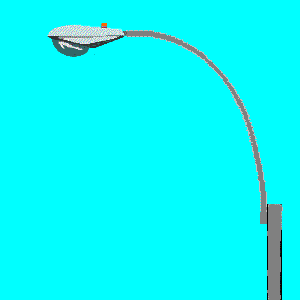 I was always on the lookout for things that set me apart from
the mainstream. We lived in a building that was not evenly divided
on each side, with an elevator in the center and 2 staircases
at each end, like the neighboring buildings had. Therefore, I
hated my asymetrical building. My street wasn't a two way street,
which made it seem somewhat stigmatized to me. I didn't hate the
street though, but I did want to live on a two way. At least there
were plenty of other one ways around.
I was always on the lookout for things that set me apart from
the mainstream. We lived in a building that was not evenly divided
on each side, with an elevator in the center and 2 staircases
at each end, like the neighboring buildings had. Therefore, I
hated my asymetrical building. My street wasn't a two way street,
which made it seem somewhat stigmatized to me. I didn't hate the
street though, but I did want to live on a two way. At least there
were plenty of other one ways around.